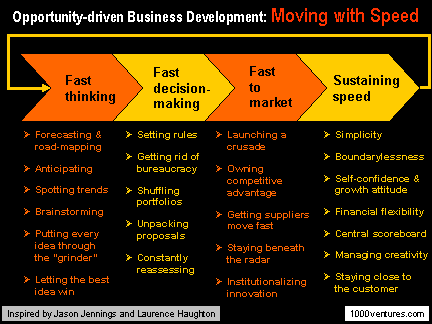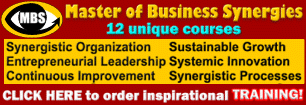|
Moving with Speed |
by Vadim Kotelnikov & Ten3 East-West
"It's not the big that eat the small... it's the fast that eat the slow" - Jason Jennings and Laurence Haughton, 2000
|
Mastering Your Anticipating Skills |
Setting Rules and Guiding Principles |
|
Achieving Speed and Maintaining Velocity - the Key to Success In the new economy where everything is moving faster and it's only going to get faster, the new mantra is, "Do it more with less and do it faster".1 In order to get real speed decisions at virtually every level must be made in minutes, not days or weeks. Decisions also have to be made "face-to-face, not memo-to-memo. This means that people have to think on their feet, and that the forests of meaningless paper trails and approvals - so common in large organizations - must be eliminated."5 Entrepreneurial Mindset Venture values are different from established corporate shared values. "Entrepreneurial independence demands space for action and trust, while independence in a corporation implies responsibility and control imposed from above. Entrepreneurial speed demands agility, experimentation, adaptation, and rapid response in order to be first to market. Corporate experimentation comprises analysis, review, sober consideration of facts, and willingness sacrifice speed for thoroughness. Entrepreneurial paranoia - competitors are catching up to us - is overshadowed by an essential need to build corporate consensus and minimize perceived risk."7...More Preparing Minds - the New Task of Strategic Planning To meet the new challenges, this process should be redesigned to support real-time strategy making and to encourage 'creative accidents'. A successful strategy-planning process would help your company to react quicker to emerging opportunities and make faster decisions than your competitors do. It would ensure that your executives have a strong grasp of the strategic context they operate in before the unpredictable but inevitable twists and turns of your business push them to make critical decisions in real time4...More How To Think Faster Than Your Competition To be able to think fast, you need to "understand the primary drivers of change, work at staying plugged in, constantly search for new combinations, and work on developing a sense of heightened perception1". The fastest companies in the world think fast because of their ability to:
Case in Point: General Electric (GE) "My job today is ten times faster than it was five years ago. A hundred times. The pace is enormously quicker because of technology. So everyone has to gearing themselves to a faster pace, to more competitiveness, to more intellectual capital. That's the game,"6 said Jack Welch, the legendary former CEO of GE, in 1997. Welch summed up his prescription for winning in three words: In his 1993 Letter to Share Owners, the CEO talked more about speed and boudarylessness than any other topic. He gave some examples of GE's speed:
|
Bibliography:
-
"It's Not the Big that Eat the Small... It's the Fast that Eat the Slow", Jason Jennings and Laurence Haughton, 2000
-
"Relentless Growth", Christopher Meyer, 1998
-
"Radical Innovation", Harvard Business School, 2000
-
"Tired of Strategic Planning?", The Times of India, 07.11.2002
-
"Jack Welch and the GE Way", Robert Slater, 1999
-
Jack Welch, interview, July 22, 1997
-
"Venture Catalyst", Donald L. Laurie, 2001




